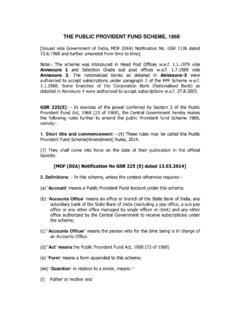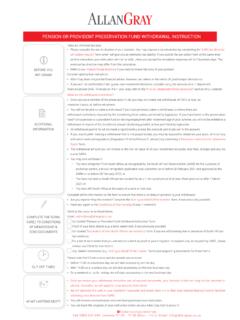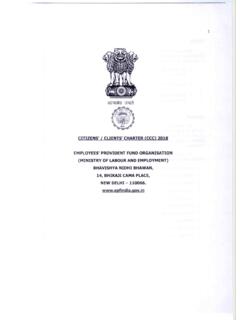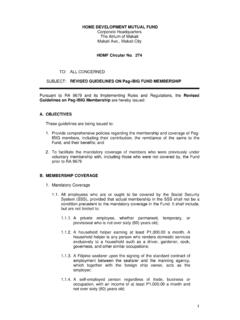Transcription of Encouraging South African households to save more for ...
1 1 14 December 2021 Encouraging South African households to save more for retirement Introduction Government has been progressively reforming and restructuring the savings and retirement legislative framework since the publication of a set of discussion papers following the announcement made in the 2012 Budget1. All these papers are available on the National Treasury website2. This paper deals with the key outstanding proposals from the retirement reforms initiated in 2012, regarding the promotion of higher level of savings, expanding coverage and promoting better preservation and more consolidation to reduce the costs and charges on members. This discussion paper makes proposals on the design structure of a two-pot system for retirement savings, which would restructure retirement savings to allow for limited pre-retirement withdrawal and introduce Government s longstanding retirement reform proposal on preservation.
2 Government will also introduce legislation to enable automatic/mandatory enrolment to expand coverage for more vulnerable, contract and temporary workers ( domestics workers, uber drivers). Whilst workers that are formally employed and belonging to a labour union tend to be covered under the current dispensation, this is not the case with workers not belonging to any labour union, nor those in the gig economy. Further, consolidation of the retirement fund sector into a smaller number of large retirement funds could bring a few cost advantages to funds and members including economies of scale, improved governance and disclosure. Annexure A to this paper provides further details. A limited level of immediate access will be made available under specific conditions for those negatively impacted by the COVID-19 pandemic and similar emergencies. The proposed restructuring of retirement savings aims to address the situation where many members of funds find themselves cash strapped (because of not having any alternative or sufficient forms of short-term savings) and then they resign from their jobs to access their retirement savings.
3 Such withdrawals should not undermine the long-term objective of building savings for retirement; 1 2 2 hence the design of the two-pot system which includes a preservation requirement to improve retirement outcomes and maintain the integrity and sustainability of retirement funds. Public comments are requested on this paper by 31 January 2022. It is the intention that draft legislation will be published in line with the 2022 Budget process to give effect to the proposals in this paper, considering the comments received. Helping households to save more to reduce vulnerability South African households do not save sufficiently for retirement nor their short-to-medium-term needs. Household savings average just above 2 percent of GDP per annum, most of which is contractual savings for retirement funds. However, aside from the low level of savings for retirement, members tend not to preserve their savings, and commonly access them when leaving their jobs.
4 As a result, replacement values at retirement are low. According to the Sanlam Benchmark Survey 2021 Report3 (p 47) in South Africa, the average replacement ratio is around 25 percent to 30 percent, resulting in retirees simply concluding that they cannot survive on the starting pension offered by a guaranteed annuity . Discretionary savings are also low, for example, one in three (34 percent) respondents to the annual Old Mutual Savings and Investment 2021 survey stated that they do not have enough savings to last more than a month (at most) if they lost their income/jobs. Furthermore, the survey indicated that 56 percent of respondents had high and overwhelming financial stress levels in 2021. This means that most South Africans are vulnerable while they are working and, in their retirement, when many can no longer work, find employment or their health is failing them. Knowledge of investment, discretionary savings, and retirement savings is generally poor in South Africa, and individuals do not save for rainy days or retirement.
5 They do not sufficiently insure their lives for the benefit of their dependents nor insure properties in case of a loss. Financial education is key for all South Africans to help reduce financial stress and increase income in retirement. The earlier working households start to save and be financially informed, the better the financial outcome throughout their life cycles. The COVID-19 pandemic has demonstrated the fragility of households , and the need to proceed with more speed with government s initiatives to increase household savings and make households less vulnerable. Many economies across the globe are currently facing economic decline because of the pandemic, which has forced several jurisdictions to come up with extraordinary proposals to avoid economic collapse and allow access to retirement assets to help the economy and households . 3 3 In South Africa, many small businesses are shutting down during this period of the COVID-19 pandemic.
6 According to Statistics South Africa (STATS SA), a net decrease of 1,4 million in total employment in Q1: 20214. South Africa has a well-developed retirement fund system that many of its workers depend on, thus enabling them to build up assets to retire comfortably. The reforms implemented over the past decade aim to reduce vulnerability in retirement, with the completion of recent reforms to post-retirement preservation implemented from 1 March 2021. The next phase of amendments now aims to ensure a more conducive policy environment to encourage pre-retirement preservation, while still supporting the financial needs of members. Policy options to amend the retirement system to improve pre-retirement preservation were detailed in the paper Preservation, portability and governance of retirement5 funds that was released on 21 September 2012 and in the paper 2013 Retirement reform proposals for further consultation released on 27 February 20136.
7 The provisions that govern pre-retirement withdrawals aim to balance three objectives: Encourage savings through regular contributions to a retirement fund during a person s economically active years; Preserve retirement funds as far as possible to fund benefits in retirement; and Allowing partial access to retirement funds to cater for periods of financial distress and improve flexibility. Government recognises that precautionary savings have merit beyond its contribution to retirement benefits. In a high-risk environment, some level of pre-retirement access to retirement savings enables households to reduce unexpected financial hardships and may lead to a greater willingness to save through retirement funds. While ongoing analysis has pointed out the disparities in pre-retirement access provisions for different retirement products, the extraordinary shocks that members and their households have experienced recently have illustrated the need for a balance that retains an appropriate measure of flexibility while improving preservation over the longer term.
8 Outstanding reforms to the retirement system relate to the following three key remaining problems: Coverage: Whilst the current retirement system covers many workers, there remain significant categories of workers who are not participating in any retirement scheme; 4 Statssa, Quarterly Labour Force Survey Quarter 1: 2021, p. 4 5 6 4 Preservation: Many members of retirement funds do not preserve their savings, tending to cash out every time they change jobs. Whilst the default regulations do assist with preservation, significant loopholes remain; and Costs: Whilst the costs applying to retirement funds might be made more transparent, most of the cost structure of retirement funds relates to the size and number of funds, which are not economical. Government has announced its intention to respond to these three challenges, by introducing an auto-enrolment or mandatory system of retirement saving for all employed and self-employed persons, to widen and deepen coverage.
9 Secondly, there is a need to consolidate the many funds into a few bigger funds, to reduce costs for all members. Thirdly, government would like to introduce a two-pot system, to allow for limited withdrawals by members and to remove loopholes that have undermined preservation. Retirement fund members and contributions According to SARS IRP5 certificate data, in 2017/18 there were around million individuals who contributed to a pension fund , provident fund , or retirement annuity fund , with around million making contributions to a pension fund , million to a provident fund , and million contributing to a retirement annuity fund . It must be noted that many individuals have membership to multiple funds, therefore due to duplication, the total, by fund type, does not add up to the total number of individuals in the second column. Table 1: fund membership numbers7 Source: SARS anonymised tax data In terms of contributions, a total of R246 billion was contributed into these accounts in 2017/18.
10 The largest contributions were made by employers to pension funds, at close to R100 billion, with R53 billion in contributions by employees. provident fund employer contributions were around R44 billion with employee contributions at R19 billion. Retirement annuity fund contributions were around R32 billion. 7 From 2016/17 onwards provident fund employee contributions became deductible and a higher percentage contribution for all retirement funds was allowed, alongside a monetary cap of R350 000. 5 Table 2: fund contributions Source: SARS anonymised tax data What is the problem? There are two main concerns with the current policy design of retirement funds: 1. There is insufficient preservation of retirement funds before retirement; and 2. Individuals in financial distress can access all their retirement funds upon resignation, and hence are left with very low, if any, savings when they retire.


















